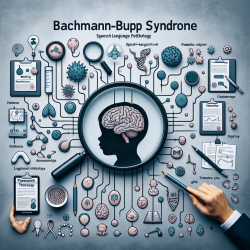Introduction to Bachmann–Bupp Syndrome
Bachmann–Bupp syndrome (BABS) is an ultra-rare neurodevelopmental disorder characterized by developmental delay, hypotonia, and non-congenital alopecia. It is caused by mutations in the ornithine decarboxylase 1 (ODC1) gene, which disrupts the polyamine pathway. This pathway is crucial for cell growth and development, and its disruption can lead to significant physiological challenges.
Research Insights and Treatment Innovations
The recent study on BABS highlights the potential of drug repurposing as a treatment strategy. The use of α-Difluoromethylornithine (DFMO), an ODC inhibitor, has shown promise in treating BABS by improving hair growth, muscle tone, and developmental milestones in affected children. DFMO has a well-established safety profile in pediatric use, making it a viable option for treating this condition.
Implications for Practitioners
For practitioners in the field of speech-language pathology and pediatric therapy, understanding the implications of this research is crucial. Here are some key takeaways:
- Early Diagnosis and Intervention: Recognizing the symptoms of BABS early can lead to timely intervention and better outcomes. Practitioners should be aware of the signs such as developmental delays and alopecia.
- Collaboration with Medical Professionals: Engaging with geneticists and other medical professionals can facilitate a comprehensive approach to treatment. This collaboration can enhance the therapeutic strategies employed in managing BABS.
- Utilizing Data-Driven Approaches: The use of standardized outcome measures and data collection is essential for tracking progress and adjusting treatment plans accordingly.
Encouraging Further Research
While the current findings are promising, further research is necessary to fully understand the long-term effects of DFMO treatment and the broader implications of polyamine pathway disruptions. Practitioners are encouraged to contribute to ongoing research efforts by documenting case studies and sharing insights from clinical practice.
Conclusion
The discovery and treatment of Bachmann–Bupp syndrome exemplify the power of scientific collaboration and innovation. By staying informed and engaged with the latest research, practitioners can significantly enhance the quality of care provided to children with rare neurodevelopmental disorders.
To read the original research paper, please follow this link: Bachmann–Bupp syndrome and treatment.










